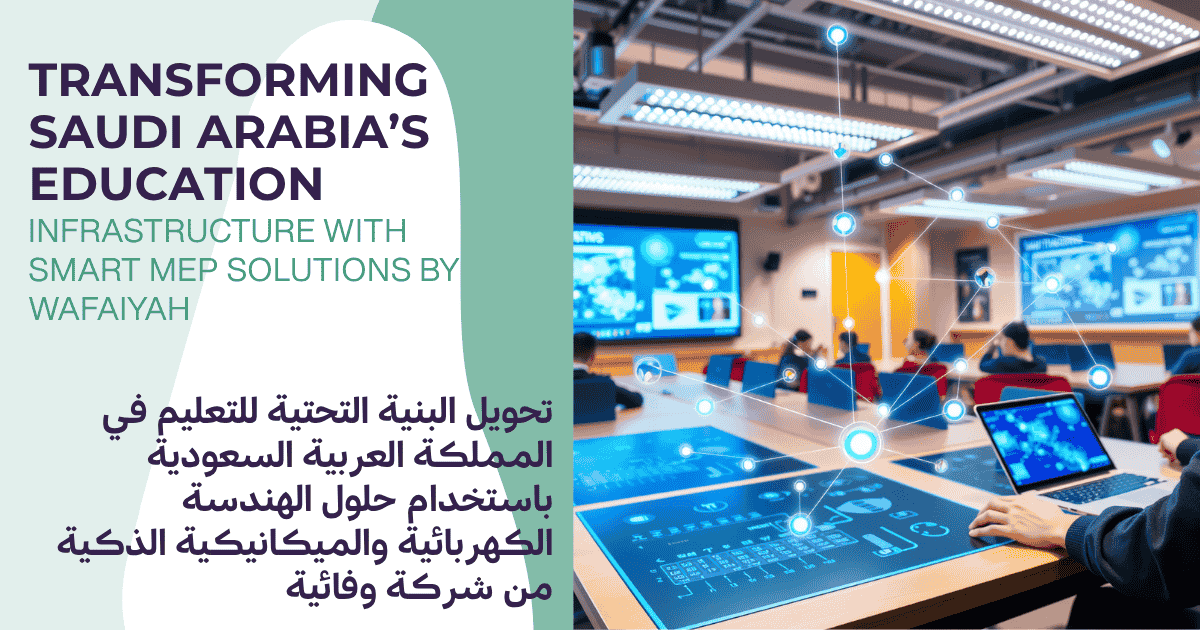Saudi Arabia’s Vision 2030 focuses on building a strong, knowledge-based economy driven by innovation and technology. Education plays a key role in achieving this vision by creating modern learning environments that inspire creativity and growth. MEP systems, Mechanical, Electrical, and Plumbing, form the core of any functional building, ensuring safety, comfort, and efficiency. “Smart MEP solutions” take this further by using intelligent systems to manage energy, climate, and resources effectively. Wafaiyah supports this transformation, helping modern schools adopt sustainable and connected infrastructure for a smarter future.
The education sector in Saudi Arabia has been expanding at a high rate. New schools and universities have been emerging to define a good learning platform. Nevertheless, several older buildings experience constant challenges, including energy wastage, lack of proper air flow, and the comfort of the students and teachers. The systems which are not up to date also increase the cost of operation and reduce efficiency.
With the increasing technological aspect of education, modern smart infrastructure is not a choice anymore, but a necessity. Modern systems provide a more comfortable and sustainable learning environment and reduce the long-term cost. The investment in the new mechanical, electrical and plumbing (MEP) systems guarantees that the institutions stay competitive and address the needs of the current students and educators.
Introduction About Smart MEP Solutions
Smart solutions use the latest technologies for the management of the mechanical, electrical, and plumbing systems of a building to achieve better performance. They are based on automation, sensors, and real-time monitoring to regulate the consumption of energy and enhance comfort.
Internet of Things (IoT) gadgets are collecting and transmitting data. Building Information Modeling (BIM) assists in creating superior design and planning. It all comes with a Building Management System (BMS) that can be easily controlled on a central platform.
Smart HVAC systems that can automatically adjust temperatures, occupancy-sensitive lighting, and water leak or water optimization are all examples. A combination of these innovations makes smart solutions assist schools and universities in providing safe, comfortable, and energy-saving environments to students and staff.
Knowing the Significant Benefits of Smart MEP in Education
Lower Energy and Water Bills
Innovative systems apply real-time data to minimize wastage and regulate the use of energy and water. The lighting is automated, and its HVAC systems are efficient. Thus, power is only consumed when it is required, thus reducing utility expenses. This enables the schools to allocate the savings for the improvement of facilities and programs of learning.
Better Indoor Comfort and Air Quality
There are sensors that check the temperature, humidity, and CO 2 so that the classrooms can be comfortable and healthy. Smart ventilation provides a constant flow of fresh air, enhancing concentration and health. An indoor environment that is comfortable makes the students remain alert and contributes to increased learning during the day.
Safer Learning Environments
Smart systems improve safety through fire detection, emergency lighting, and ventilation control. The use of real-time notifications can enable them to respond promptly to possible dangers, thereby reducing risks for students and staff. Through the systems, learning institutions can enjoy a safe and dependable atmosphere daily.
Eco-Friendly with Sustainability Goals
Smart solutions contribute to the sustainability vision of Saudi Arabia by reducing carbon emissions and the consumption of resources. Schools that are using renewable energy and efficient systems are environmental leaders. Such a promise not only contains cost reductions but also educates students about responsible living.
Data-Driven Maintenance and Longer Life
Constant observation enables early identification of problems which minimizes breakdown and cost of repair. Smart systems gather data used to perform predictive maintenance, which prolongs the life of equipment. This strategy maintains a smooth flow of operations, comfort, and reduces the overall cost of ownership in the long term.
Insights on Key Components of Smart MEP Systems
Mechanical: Smart HVAC and Air Quality Sensors
Smart HVAC systems automatically regulate temperature and airflow to keep the environment comfortable without consuming much power. CO2 and humidity sensors also monitor the air quality, hence creating a healthy learning environment.
Electrical: LED Lighting, Renewable Power, Smart Meters
The LED lighting system helps to save energy. Smart meters monitor electricity consumption in real time, and renewable sources of energy, such as solar panels, can be used to decrease reliance on the grid.
Plumbing: Leak Detection and Greywater Recycling
Smart plumbing has sensors that ensure that leaks are detected at an early stage, so that water is not wasted and damaged. The greywater recycling systems make use of the water to irrigate or clean. This contributes to the sustainability objective and decreases the use of water.
Automation: Central Monitoring and Controls
Building Management System (BMS) brings all the MEP elements to a single platform. Facility managers can track performance, modify settings and get alerts in real-time, enhancing efficiency and control.
Importance of Modern Smart HVAC for Saudi Arabia
The climate in Saudi Arabia is harsh. This makes the cooling efficiency one of the priorities in educational buildings. Smart HVAC systems contribute to a decrease in energy demand and comfortable conditions for the students. As water shortage is a national issue, smart plumbing solutions will make sure that each drop will be counted using real-time monitoring and recycling. The technologies are in line with Vision 2030, which is supportive of efficient and sustainable infrastructure in all sectors, including education.
We all know that KSA is investing in modern learning facilities. Incorporation of innovative systems helps in long-term expansion, economies, and environmental sustainability. Not only do they modernize schools and universities, but they also make them comfortable and productive. This way, educational settings would be at the same level as those in the world in terms of safety, sustainability, and innovation.
Necessary Implementation Steps for MEP System
Assess Current Building Systems
Start with an assessment of the current systems and determine what is inefficient and what requires improvement. Awareness of the existing energy consumption helps develop a clear base upon which future upgrades can be formulated.
Plan Smart Upgrades (Energy Audit, Goals)
Carry out an energy audit and establish quantifiable objectives. This phase identifies the scope of the project, the budget and performance goals to make the best out of the upgrades.
Design with BIM and Choose the Best Equipment
Design systems that fit perfectly into each of the facilities using Building Information Modeling (BIM). Select smart, compatible and high-efficiency equipment to be reliable in the long run.
Install and Connect Systems to BMS
Use the centralized Building Management System to incorporate all mechanical, electrical and plumbing components. This enables real-time monitoring and easy control through a single platform.
Train Staff and Monitor Results
Give practical training to the facility teams in dealing with new technologies. Monitor performance metrics to evaluate outcomes and continuously enhance them.
Common Challenges and Solutions You Should Know
There are a few significant challenges associated with the implementation of innovative systems, and each of them can be practically solved. The large initial expenditures can be paid for by saving on energy and maintenance in the long run. Closing the skill gap may be achieved through the training of the facility staff and technicians in smart technologies and data management.
The problems of integrating are addressed by selecting open and compatible systems that can be upgraded in future. Through suitable planning and encouragement, these threats can be used as a chance to innovate, be efficient, and make sustainable development evident in the education sector throughout Saudi Arabia.
Conclusion
Smart MEP systems are transforming education buildings across Saudi Arabia by enhancing energy efficiency, safety, and overall learning comfort. Investing in these technologies today creates sustainable, future-ready campuses that align with Vision 2030 goals. With expert support from Wafaiyah, schools can achieve smarter infrastructure that promotes innovation, sustainability, and long-term national growth.
Frequently Asked Questions
Why is MEP important for schools and universities?
Because it controls comfort, lighting, air, and water—key factors for learning and safety.
Can old campuses use Smart MEP systems?
Yes, through phased retrofits and modular installations suited to existing spaces.
How do Smart MEP systems save energy?
They monitor and adjust usage automatically, cutting waste and lowering costs by up to 40%.
What’s Saudi Arabia’s goal with Smart MEP?
To build sustainable, energy-efficient campuses aligned with Vision 2030’s smart infrastructure goals.

